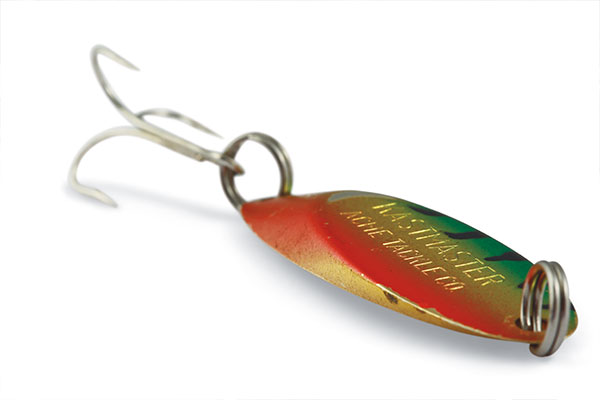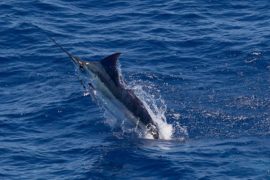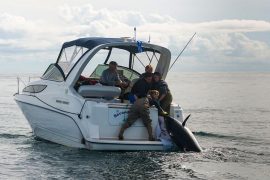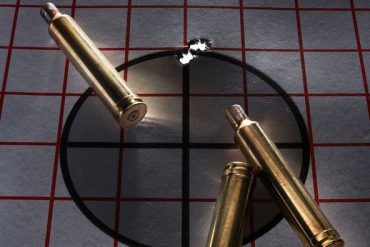I could wax nostalgic for those simpler times when I first got the fever in the 1960s; first realized there was more to ice fishing than a hook, a minnow, and a bobber; first realized some of the better anglers of those times were spooning up walleyes and perch; occasionally saw the impressive pictures in the paper; and just knew there was a simple straight line from those hot lures to fishing success; only to get those lures and see, as we all do when we really get into something, that knowledge is the key to success—although it always helps to have a great lure on the end of your line.
A lot happened along the way, including my discovery in those early days of one of the best ice lures of all time, one that has stood so many tests of time that it is today perhaps the single best yet somewhat under appreciated spoon of all time.
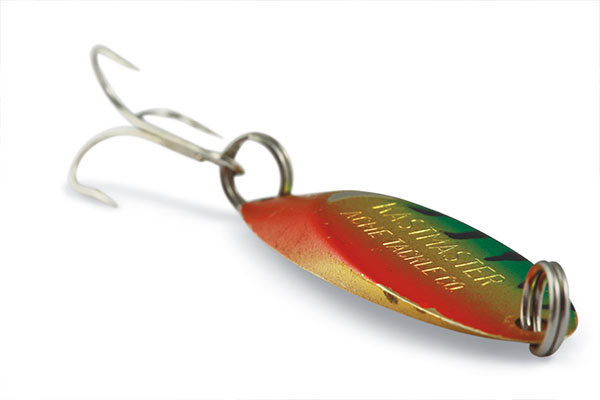
The Acme Kastmaster is such a fundamental design that by today’s standards it seems almost blasé. It’s a slightly elongated metal slab beveled thin at the head end, and progressively thicker at the butt. On the lift the head of the spoon cuts like a knife, while the butt gives off a subtle pulsing wobble. The heavier butt anchors the fall so the hook never gets near your line. You can fish a Kastmaster all day without it tangling and wasting time.
Fish it with a short gentle stroke for tentative fish. But it’s also one of the best spoons in ripping mode—and only a handful of anglers ever use it this way on fisheries like Lake Winnipeg or other big waters where walleyes sometimes roam in aggressive packs. On the rip the head of the lure vibrates intensely to call fish in, but the spoon never goes wildly out of control.
Just as in open-water fishing, depth control of lures is our primary concern. Our second concern is speed control, which is influenced by how you work the lure and the lure’s “cycle time,” or inherent fall rate. Spoons like the slab design of the Kastmaster have a quick cycle time, the opposite of broader, thinner designs like another of my favorites, the Custom Jigs & Spins Slender Spoon.
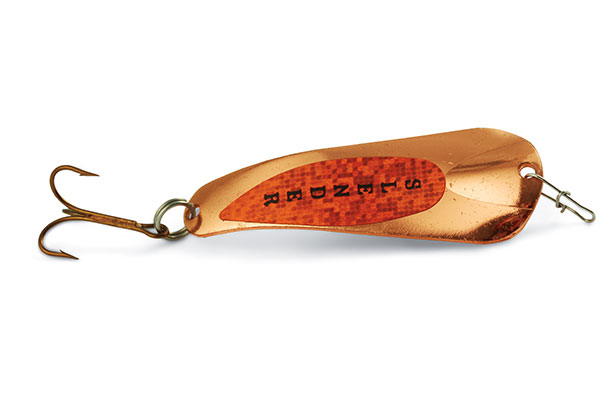
The Slender Spoon isn’t—slender, although three of the four available sizes are stamped thin, with a narrower bent butt, and broad shoulders at the top end. Where the Kastmaster offers just a hint of flash on the lift and fall, the Slender spoon immediately lays on its side and shimmies and shakes and wobbles as it falls—slooooow cycle time. Lots of flash and vibration, whereas the Kastmaster falls quickly and, by comparison, just flashes and wobbles enough to hint that it’s something a fish might want to eat.
I have written many times before, but it bears repeating, that a spoon is an illusion. Often the illusion is little more than subtle delivery device for a tasty, aromatic morsel of something fishy, like a minnow head or a whole minnow. A little flash, a little vibration—a hint of color. It’s something injured, something struggling (on the lift-fall). And then it hangs vertically, for all purposes disappearing on the pause, except for whatever you tipped the spoon with, which can be critical, but other times need be no more than almost nothing, which is to say a bare hook.
At times the jigging process is like calling ducks or geese or turkeys or elk. When the critters haven’t been bothered and are looking aggressively for food or company, call boldly and often, often using lures that are a step or two more “outstanding” than a spoon—or at least fish with “bold” spoon like the Slender Spoon. Other times, when they’ve been worked over, have become wary, or environmental conditions aren’t perfect, just hint at the presence of something. Touch off a spark of curiosity. Don’t let them find you easily—make them search. Or don’t show them something that’s obviously food—make them wonder until they have to sample to be sure.
With a spoon, the idea often is to hint subtly at this and subtly at that by lifting and letting it fall. The illusion continues as the fish draws near. The fish is reacting to a set of simple cues. Something flickered and flashed, wiggled, and fell. Based on past experience, the fish is predisposed to think food. We have to continue the ruse long enough to get the fish to sample.
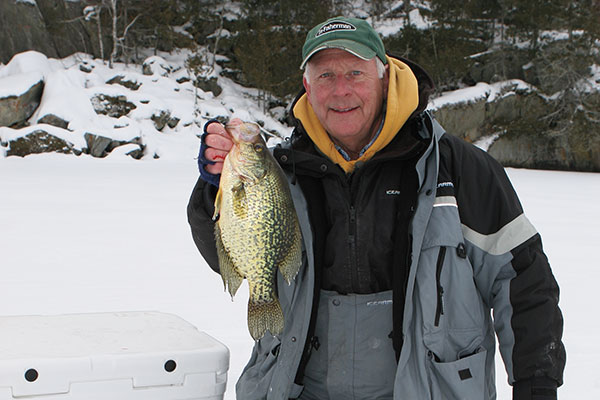
Thus anglers need spoons on each end of the cycle spectrum—so the Kastmaster on one end, the Slender Spoon on the other. The Slender Spoon that fishes best for me for larger predators is the 5/16-ounce option, which is a thicker design than the others, still offering lots of flash and vibration, but with a quicker cycle time. And it comes to rest and finishes spinning on its axis much more quickly than the thinner Slender Spoons, which often do a great job of attracting fish, but then spin for so long at rest that fish already drawn close sometimes reject them.
Meanwhile, with the Kastmaster, most anglers don’t understand that spoons like this usually fish best with a short quick stroke (a lift of one foot) as opposed to a high lift and long fall. That way it does its flash dance quickly, only spinning on its axis a time or two before coming to rest, the illusion in action—or should I say “inaction.” You’re better short-stroking twice to attract fish, as opposed to making a high lift and long fall, except when you’re ripping, and even then a 1.5- to 2-foot rip is enough.
All of the rest of the spoons in play pretty much fall between those two design extremes. Years ago the Blue Fox Tingler had even broader shoulders than the Slender Spoon and a thinner butt end, so it produced even more extreme vibration and flash. It worked like magic at times, which is the way it often is with spoons on the edge. Then, for a long spell, it was off the market in the U.S., but still available in Canada. Now it’s back in the VMC lineup in the U.S.—and it’s worth having a few in your spoon box.
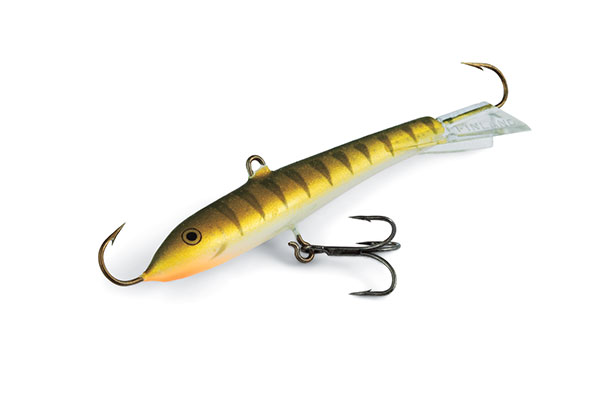
One might also vote for the Bay De Noc Swedish Pimple as one of the best fundamental designs of all time, but it’s one I never had a lasting affair with. That’s the way it is with ice lures, at times. The way you think, the way you work lures, the way you approach the fish, at times it becomes a personal thing with some lures working better for some anglers than others—so luckily we have a lot of choices today. My favorite ice lure of all time, the Rapala Jigging Rap, which I’ll talk about in a bit, is magic for me and many others, but for the life of some people they cannot catch fish with it.
Going back to the Swedish Pimple for a moment, I can never forget my first time fishing for walleyes on Lake Erie, back when the water was a lot dirtier than it is today. I walked up to a small shanty to ask how the anglers inside were doing, although I could see they already had a couple 9-pounders on the ice. Both of them had on red #7 Pimples, which are big enough to knock out a 10-pound walleye should you hit one on the head. I walked away knowing the #9 Jigging Rap that I had on wouldn’t be too big for those Erie eyes.
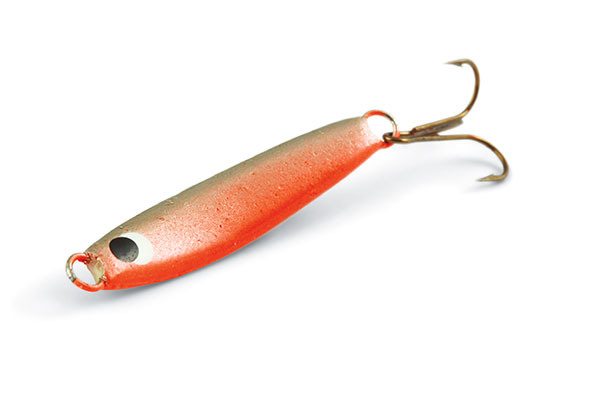
By comparison, some lures, particularly spoons without extreme action, are hard to fish so wrong that you won’t catch anything so long as you at least give them a good pause. That’s the case with the Jig-A-Whopper Rocker Minnow, which in earlier times was one of the most popular spoons of its day. That’s not the case anymore, although it fishes as well as it always did and today is marketed by HT Enterprises. I always have a few with me, particularly in some of the old color patterns. I loved the gold plating on some of the older models, with either chartreuse or a hot-orange head.
But then I almost always use some sort of gold pattern in all the waters I fish that have any color to them, which is most waters I fish, from Ontario to Illinois, from Michigan to Montana. The Rocker Minnow falls in the same basic slab category as the Kastmaster, but its slightly bent banana shape gives it a bit more action on the lift-fall.
Many great spoons like the Rocker Minnow are on the market today. The Northland Buck-Shot Rattle Spoon gets a lot of play, with its compact design and distinctive rattle chamber. My own approach to most applications on ice is toward rigging for silent running.
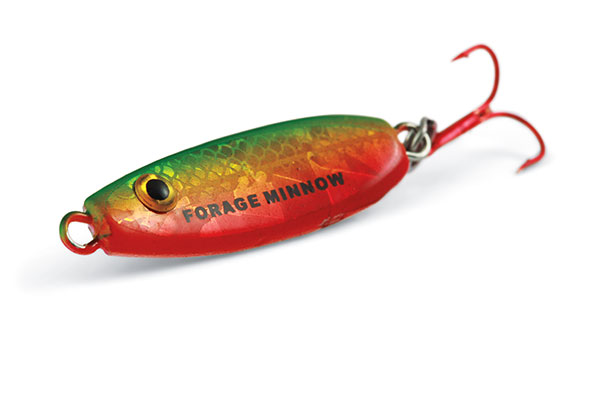
The Northland Forage Minnow is a similar design, ever-so-slightly bent, not quite so bulky, so tinkering with both options in the early days I settled on the Forage Minnow, and have never looked back. You could tie on a Gold Perch pattern Forage Minnow and never take it off the season long, going a bit smaller for perch and crappies, a bit bigger for walleyes, although a small Forage Minnow can be one of the best things on ice for hesitant walleyes.
On most spoon designs, including the Forage Minnow, I usually tip the treble hook with a minnow head for walleyes. For perch…

